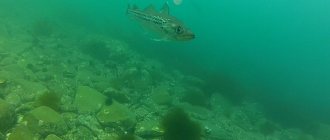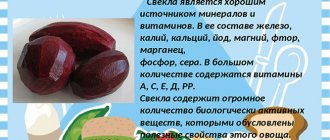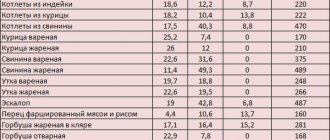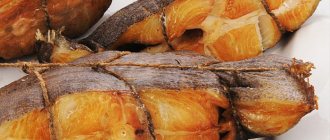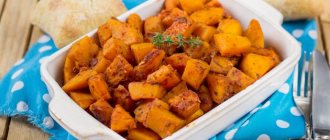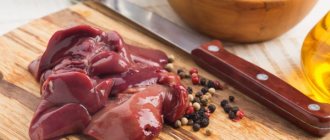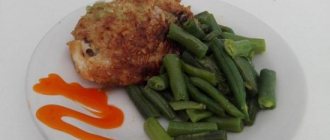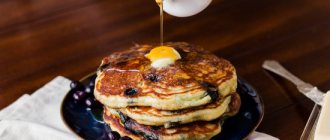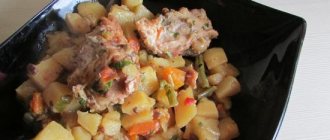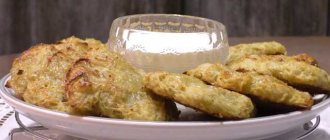Hake fish, or hake, has a low calorie content (no more than 130 kcal) and is a real storehouse of vitamins, proteins and beneficial microelements.
Even the most experienced housewife can cook it on her own. This fish has practically no bones, so it can be given to both adults and children aged 2-3 years. Due to its composition, hake is considered a dietary food. It is suitable even for diabetics, people with pancreas problems and other similar diseases. Are you preparing hake fish?
Calorie content and BZHU
Hake belongs to the group of white or lean fish due to its low fat content, which barely reaches 2% on average. For this reason, the product is classified as dietary. 100 g of fillet contains only 0.7 g of fat. Moreover, hake has a very low calorie content of 72 kcal per 100 g. A serving of baked fillet weighing 150 g and the size of a small human palm contains 108 kcal.
This is explained by the fact that the hake body consists of 81% water. The remaining 16% is valuable animal protein. This figure means that in a serving of fillet (150 g) as much as 24 g is pure protein, which has high biological value. It contains all the essential amino acids and is also highly digestible and bioavailable.
Hake fish. Benefits and harms, calorie content
Hake fish, the benefits and harms of which are of great interest, is not considered a source of omega-3, unlike other seafood. Its meat contains 2 fatty acids of this group (EPA and DHA), but in small quantities (from 0.30 to 0.37 g per 100 g).
However, hake meat contains a significant amount of microelements necessary for humans:
| Microelements | Contents per 100 g of hake fillet | Percentage of the recommended daily intake for an adult |
| potassium | 294 mg | 14,7% |
| phosphorus | 142 mg | 20,29% |
| selenium | 36 mcg | 65,45% |
| vitamin B12 | 1.1 mcg | 44% |
| Niacin (B3) | 1.1 mcg | 44% |
As you can see, this fish is high in B vitamins. Just 100 g of the product offers almost half the daily requirement of these compounds. The content of phosphorus, potassium and selenium is also very significant.
The nutritional value
Merluza is a sea fish that is considered much healthier than river fish. It is rich in many substances vital for humans, ensuring the normal functioning of the entire body, including the brain.
Proteins fats carbohydrates
Hake meat is highly valued as a rich source of high-quality protein, which, given the complete absence of carbohydrates, low fat content and low calorie content, makes it a sought-after component of dietary nutrition. 100 grams of product contains:
- proteins - 16.6 g;
- fats - 2.2 g, of which saturated fatty acids - 0.6 g;
- carbohydrates – 0 g.
On the other hand, fish oil has health benefits, so its presence adds value to the product. Despite the fact that hake is a lean variety of sea fish, it contains a sufficient amount of useful polyunsaturated Omega-3 acid, especially in caviar. Therefore, when used for therapeutic and prophylactic purposes, it is recommended to purchase not fillets, but whole fish with caviar.
Omega-3 has a number of beneficial effects:
- protects against diabetes;
- prevents disorders of the cardiovascular system;
- reduces the severity of hypertension;
- improves reproductive function;
- normalizes the activity of the thyroid gland;
- has a beneficial effect on the central nervous system;
- gives stability to the nervous system.
Another valuable substance present in fish is methionine. This is an essential sulfur-containing amino acid, which has no fewer beneficial effects for the body:
- is an important participant in protein synthesis;
- promotes the breakdown of lipids, preventing the deposition of fats in the liver;
- has antioxidant properties, protects against toxins and free radicals, prevents cell destruction;
- increases the body's ability to cleanse itself;
- eliminates swelling caused by excess fluid in tissues.
As the basis of proteins and hormones, methionine is involved in many vital processes, including energy metabolism and the transport of fatty acids into mitochondria. Thanks to these properties of methionine, taking into account the high protein content and low calorie content, hake can be called an ideal product for weight loss.
Macro- and microelements
Merluza, like any sea fish, is a rich source of important minerals, macro- and microelements. The main components of the chemical composition provide the following beneficial effects:
- iodine - strengthens the immune system, increases strength and energy, has a beneficial effect on the activity of the brain and thyroid gland, improves the condition of teeth, skin, nails, hair;
- phosphorus - supports mental and muscle activity, growth and development of bone and dental tissue, maintains metabolism and acid-base balance;
- sodium - activates pancreatic enzymes, normalizes water-salt metabolism and acid-base balance, activates the production of gastric juice, dilates blood vessels, improves the functions of the nervous and muscular systems;
- magnesium - lowers blood pressure, regulates heart rate, normalizes sugar levels, improves respiratory function, prevents muscle and joint pain;
- manganese - promotes the rapid absorption of vitamins, improves the functioning of the central nervous system, regulates carbohydrate and fat metabolism;
- potassium - reduces blood pressure and the risk of stroke, prevents muscle loss, prevents the formation of kidney stones, regulates water balance and controls the electrical activity of the heart and other muscles;
- iron - participates in the formation of blood cells, promotes the transfer of oxygen to cells and the formation of hemoglobin, neutralizes toxins;
- cobalt is involved in hematopoiesis, participates in the synthesis of amino acids and the breakdown of macronutrients, activates metabolic processes, stimulates the development of red blood cells.
All of these elements are present in an easily accessible form and are fully absorbed, providing the most effective effect on the body.
Vitamins
The vitamin composition of hake is not as rich as the mineral composition, but it contains the most important vitamins for humans:
- C - a powerful antioxidant with a pronounced anti-allergenic and anti-inflammatory effect, provides immune protection and mental stabilization, participates in the synthesis of many substances, regulates blood clotting, and activates hematopoietic processes;
- A − regulates the balance of minerals, promotes active synthesis of proteins and fats, improves vision;
- E - normalizes the functioning of the reproductive system, has a beneficial effect on the cardiovascular, endocrine and nervous systems, increases oxygen consumption by tissues;
- B1 – stabilizes blood circulation;
- B2 – increases the ability of cells to absorb oxygen;
- B6 – accelerates metabolism and fat burning;
- B9 – normalizes liver function, strengthens immune defense;
- PP - activates the conversion of carbohydrates into glucose.
The complex of vitamins, minerals and other useful elements contained in hake helps to heal and cleanse the body, improves metabolic processes and ensures the prevention of many serious diseases, including cancer. The low calorie content of hake, a large amount of easily digestible protein, and the presence of some unique and a whole complex of vital substances make this fish a valuable component of any food, including dietary nutrition.
Beneficial features
Hake fish, the benefits and harms of which are often actively discussed, can definitely improve the functioning of the human body. This is explained by the presence in meat of a whole set of organic and inorganic components, which have a very good effect on the well-being and functioning of certain organs. Therefore, hake should certainly be added to the regular diet of people suffering from certain diseases or who are at risk.
The proven beneficial properties of the product are as follows:
- increases metabolic rate;
- reduces blood glucose levels;
- has a therapeutic effect for hormonal disorders, especially for problems with the thyroid gland;
- stops the development of harmful microorganisms;
- improves the functioning of mucous membranes;
- fights inflammatory processes;
- improves immunity and increases resistance to infection by various bacteria and viruses;
- has a good effect on visual acuity;
- helps improve skin condition;
- helps the body recover after serious stress (both mental and physical);
- promotes faster recovery of orgasm after illness and injury.
Given these features, dishes from this fish must be constantly consumed by people from certain risk groups. First of all, these are those who regularly experience increased stress and suffer from chronic lack of sleep and are constantly exposed to stress. Consuming hake will also remove free radicals and prevent the development of dangerous bacteria in the body. Thanks to such a wide list of beneficial properties, the product can improve the functioning of many body systems.
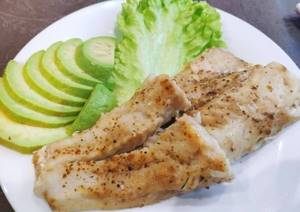
Therefore, regular consumption of hake is recommended for people who have the following health problems:
- diseases of the digestive system;
- menstrual irregularities and the onset of menopause;
- infection with infections or viruses;
- excess weight;
- diabetes.
Hake is especially useful for diabetes, as it can reduce glucose levels in the body. At the same time, the fish is low-fat, and is quite suitable for the dietary menu, which is mandatory for this disease.
Possible harm and contraindications
Hake fish, the benefits and harms of which should be known to everyone, is still not ideal. Even with a large list of beneficial properties, there are some contraindications to its use in significant quantities.
Hake can cause harm in some cases:
- if you have allergic reactions to fish and seafood;
- for chronic constipation (the product contains a lot of iron, the consumption of which aggravates this problem);
- stomach diseases with high acidity (fish contains a number of acids that can worsen your health).
Tips for buyers. How to choose Heck?
The main criterion for the quality of hake is the ratio of the size and weight of the carcass. A good fish should be moderately heavy.
If hake looks like it weighs no more than 200 grams, but the scale shows 400, then know that the manufacturer did his best and sincerely “saturated” his product with water. Consequently, you will overpay twice for the goods, and you will receive not fish, but a bunch of fibers torn by ice.
At the same time, there should still be a thin layer of ice glaze on the fish, otherwise during storage it will dry out and lose its taste and smell.
Fillet in batter
Hake is a delicate white fish similar in texture and flavor to haddock, cod, flounder and halibut. Regardless of the method, its preparation occurs very quickly, and determining readiness is not difficult. After heat treatment, the fillet becomes very soft and matte. The most famous and widespread hake dish is pieces of fillet fried in soft batter.
What ingredients will you need?
- 125 g bread flour;
- sea salt and black or white pepper;
- 3 g cayenne pepper;
- 5 g oregano;
- 2 large eggs;
- 5-6 pieces of hake fillet, fresh or defrosted;
- oil for frying.
Step-by-step cooking process
- The flour must be mixed well with salt, oregano, cayenne and black or white pepper and poured onto a flat plate.
- Break the eggs into a separate bowl, beat them a little with a fork and add salt.
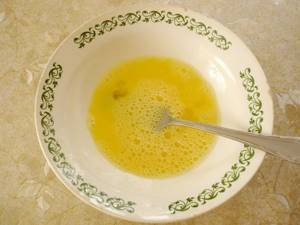
- The fillet pieces should be well coated in seasoned flour, then dipped in the egg and then dipped in the flour again.
- Next, you need to heat the vegetable oil in a frying pan and place the fish in it, fry until a brown crust forms on each side.
- The fillet is ready when it can be easily pierced with a fork.
What can I add?
Flour can be mixed with any dry seasonings and spices to your liking. Eggs can be mixed with a little mustard or chili sauce.
Rules for serving and decoration
Serve the fried fillet in batter hot. As a side dish, mashed potatoes or French fries are best. To add juiciness to the dish, you can serve it with a salad of raw vegetables or slices of fresh tomatoes. Any creamy or savory sauce with plenty of seasoning will work well for dipping. Fried fillets that are not eaten immediately can be stored in the refrigerator for 3-4 days.
How to choose and store correctly
Best materials of the month
- Coronaviruses: SARS-CoV-2 (COVID-19)
- Antibiotics for the prevention and treatment of COVID-19: how effective are they?
- The most common "office" diseases
- Does vodka kill coronavirus?
- How to stay alive on our roads?
If the purpose of the purchase is fresh hake, then it is important to follow the generally accepted rules for choosing fish. In short, fresh fish should have shiny eyes, pink gills, and a springy body that does not leave any dents when pressed.
A good frozen product is one that has not been re-frozen. Most often, hake goes on sale frozen, since when fresh it quickly loses its taste. Since even frozen hake dries out very quickly, as a rule, after any freezing method, the carcass is glazed with a thin ball of ice. If the fish is too light for its size, this means that, most likely, almost all the liquid from the meat has already evaporated. It is better not to take such fish; when finished, its fillet will be dry and tasteless. Fish that is too heavy is a sign of excessive glazing, which will affect not only the cost of the carcass, but also its taste.
Fried
Hake can be fried without using batter. To cook fish in a frying pan in the easiest way, you only need salt and a little oil. Frying in its pure form, without additives, allows you to get a crispy, golden-brown skin, which many people really like.
What ingredients will you need?
- hake fillet (boneless);
- frying oil;
- salt and other spices (to taste).
Step-by-step cooking process
- Place a shallow frying pan on the stovetop over medium heat and drizzle with enough oil to coat the bottom. When it starts to sizzle, you can start cooking the hake.
- Next, you need to place the fillet in the pan, skin side down. The fish will begin to sizzle as soon as it touches the hot oil. It is necessary to arrange all the fillet pieces at a noticeable distance from each other to avoid crowding or sticking.
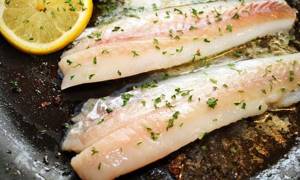
- Fry the fillet on one side for 3-4 minutes. This is usually enough to get the skin browned and crispy.
- Then you need to insert a spatula under each piece, turn them over and press them into the pan for a few seconds. This will help heat the other side of the fillet evenly and make it softer.
- On the second side of the hake you need to fry for about 1-2 minutes. You can use the sharp edge of a spatula to pierce a piece of fish to check its doneness. If the fillet has turned dull white and very soft, it is time to remove it from the pan.
- Immediately after frying, the fish will be very hot. Therefore, it is recommended to leave it for 1-2 minutes to cool slightly, and only then serve.
general characteristics
Hake (or hake) is a predatory sea fish from the cod family. It is easily recognized by its black mouth, narrow elongated body with silvery sides, and on its dark back, unlike other fish, there is only one fin. Adult fish usually weigh up to 3 kg and grow up to half a meter in length, although one and a half meter record holders are sometimes found.
Content:
- general characteristics
- Chemical composition and nutritional value
- What are the health benefits?
- Possible harm and contraindications
- Use in cooking
- How to choose and store correctly
- What to cook from hake
There are a dozen varieties of hake in the waters of the World Ocean. Merluzas are deep-sea fish that feel comfortable 100 meters under water, and even swim to a depth of 1000 meters. Most of them live near continents in the Pacific and Atlantic Oceans. Depending on the place of “registration”, several varieties of hake are distinguished. European - inhabit the waters from Norway and Iceland to the coast of Mauritania, and are found in the Black and Mediterranean Seas. Silvery - found near North America. Pacific (Oregon) - found from the Bering Sea to the Gulf of California. And also New Zealand ones - they stick to the shores of New Zealand and Patagonia.
By the way, different types of hake differ not only in their places of residence, but also in some external characteristics, although this has almost no effect on the nutritional value of their meat.
Boiled
Hake fish, the benefits and harms of which are discussed very actively when drawing up various dietary menus, can be prepared by boiling. The result is a broth that can be used as a base for soup. The boiled fillet itself is soft, tender and quite tasty.
What ingredients will you need?
- hake fillet (boneless);
- water;
- diced onion, carrots and celery;
- aromatic spices (lemon slices, whole peppercorns, bay leaves, allspice, etc.).
Step-by-step cooking process
- You need to fill a deep pan with enough water. It should completely cover the fish and other additives once they are added.
- Next, add any aromatics of your choice (lemon slices, peppercorns, bay leaves and/or allspice) and diced onion, carrots and celery root. These ingredients can be useful in giving boiled hake a subtle piquant taste and aroma. If desired, you can add a little white wine.
- Then heat the pan over moderate heat until the liquid boils. When a strong boil begins, you need to keep the heat low for 2-3 minutes. This will allow the vegetables to release all their juices, and the aromas of the seasonings will mix into a single bouquet.
- After this, you need to turn down the fire. For best results, the liquid should cool to 71-82°C before fish can be added to it. Too high a temperature will lead to instant digestion of the soft fillet, until it disintegrates into fibers.
- Once the water has cooled, you need to carefully lower the fillets into it to avoid splashing. The fish should be positioned level (parallel to the cooking surface) and completely submerged in water. If there is not enough liquid, you need to add it to the required level (this can be not only water, but also white wine or broth).
- Cook the hake fillet for 10 minutes. The hot liquid will cook the fish quickly without damaging it. It is advisable not to stir the fillet while it is cooking, otherwise it may fall apart.
- As soon as the fish becomes matte and increases in volume (“swells”), it is ready. You need to remove it with a slotted spoon and place it on several stacked paper towels to remove excess moisture.
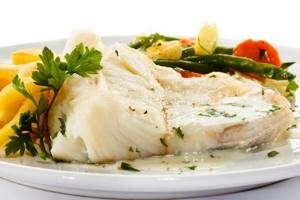
- After this, the boiled fish should be transferred to separate plates for serving. In this form, zek goes especially well with soft, juicy vegetables such as tomatoes and zucchini. Toasted or crisp-fried bread can help balance the moisture in the fish.
Dishes
From a culinary point of view, hake meat is very attractive because it is white, tender, low-boned and easily separated from the bones. In addition, such fish has low fat content, minimal calorie content and a lot of useful properties, which makes the prepared dishes an ideal dietary component of any diet. It is boiled, fried, steamed and baked in the oven. The result is excellent cold appetizers, soups and main courses.
Since this fish is very lean, it is recommended to cook it in sauces made from sour cream, cream, butter, and when fried, serve it with marinade. It should be borne in mind that when such nutritious components are added, the calorie content of hake increases several times. If this moment is important, in particular during the period of losing weight on a low-calorie diet, then it is better to refuse such supplements. Even lean hake will be quite tasty and, most importantly, will retain its original energy value.
Boiled
To maximize the preservation of beneficial properties and obtain a truly dietary dish with minimal calorie content, it is recommended to boil hake - in water or steamed. Before boiling, the fish or fillet is first cut into pieces, salted to taste, sprinkled with lemon juice and left in the refrigerator for 30–40 minutes. Then place the fish pieces on a steamer rack or in a saucepan, sprinkle with grated carrots and cook for 15–20 minutes.
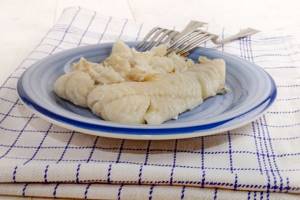
In both options, the calorie content of boiled hake is 95 kcal/100 g. In this case, the increase in the number of calories is ensured solely by increasing the amount of proteins, which makes the boiled product as useful as possible for losing weight or maintaining weight.
Fried
Fried hake is considered less useful in dietary terms, the calorie content of which is 105 kcal/100 g when fried in flour and 110 kcal/100 g when cooked in batter. In addition, the amount of protein in it decreases to 14.3 g, but the fat content increases to 3.9 g and even 2.5 g of simple carbohydrates appear. Of course, if you consume such a dish with a normal healthy balanced diet, then there will be no harm from the indicated numbers. But when following a diet or with constant monitoring of calorie intake, they can affect the final result.
Before frying, cleaned and dressed fish or fillets are cut into pieces. Salt, pepper, add other seasonings to taste. Heat vegetable oil in a frying pan. Roll each piece in flour or dip in batter and place in a frying pan. Fry over low heat on all sides until golden brown.
Fried hake is considered the most delicious dish made from this fish. It is prepared simply and quickly, goes well with any side dish, vegetables, sour cream or cream sauces with herbs. But when choosing this or that additive, you should keep in mind that many of them can further increase the calorie content of hake.
Baked
The average energy value between boiled and fried is baked hake, whose calorie content is 98.8 kcal per 100 grams. Preparing such a dish is also not difficult and takes little time. At the same time, it turns out to be just as healthy, healthy and dietary as after boiling, but has a richer taste with a crispy crust, reminiscent of fried fish.
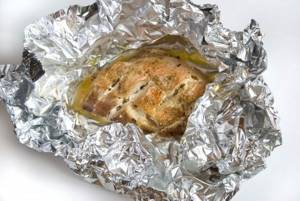
The carcass is cut into pieces, placed on a baking sheet, greased with olive oil, salt, pepper and other spices are added if desired. Bake in the oven at 180ºC for 40-50 minutes.
Stewed
For stewing, use 1 kg of fillet or whole carcasses cut into pieces. They are pre-fried without salt and spices in 4 tbsp. l. vegetable oil until half cooked. Then add grated carrots and onion cut into half rings, fry for another 5 minutes, stirring gently. Separately dilute 2 tbsp. l. tomato paste in 150 ml of water, add salt on the tip of a knife. Pour this mixture over the fish-vegetable mixture, mix carefully, and simmer for 10 minutes. Served with greens.
The calorie content of hake stewed according to this recipe is 103.2 kcal/100 g, which contains 11 g of protein, 5.8 g of fat and 2.2 g of carbohydrates. The dish is very nutritious, but can be considered dietary due to its high protein and vegetable fiber content.
Baked
The benefits and harms of hake are often mentioned when choosing the best cooking method. It is well known that even the healthiest fish will lose a significant part of its properties if it is deep-fried or mixed with sauces with a high fat content. When choosing healthier dishes, many rightly prefer oven-baked ones. Hake prepared in this way may well be considered dietary.
What ingredients will you need?
- hake fillet (boneless);
- olive oil;
- kosher salt;
- black pepper;
- assorted herbs and spices (to taste);
- any vegetables of your choice.
Step-by-step cooking process
- The oven must be preheated to 180°C and set to convection mode.
- Place each piece of hake fillet, skin side down, on a separate sheet of aluminum foil and drizzle with a little olive oil.
- Then you need to sprinkle the fish with kosher salt, black pepper, chopped lemon zest or other spices to your taste. If desired, you can add sliced vegetables and herbs. The fish absorbs the aroma of other components during the cooking process and becomes tastier. Therefore, it is recommended to bake it along with onions, garlic, capers and herbs (such as parsley and dill).
- Next, you need to lift the ends of each sheet of foil up and seal it in the shape of an envelope or twist it into a kind of knot. This will prevent liquid from leaking out during cooking, and the fish will turn out juicier. You should not wrap the fillet too tightly - you need to leave some free space in the closed package.

- The wrapped fillets must be placed on a baking sheet at a considerable distance from each other (this is necessary for proper heat circulation) and placed in a heated oven.
- Bake the hake fillet for 10-12 minutes. Be sure to set a timer to check the doneness of the fish after 10 minutes. If the fillet does not look quite cooked, you should place it back in the oven for 2-3 minutes.
- Baked hake has a soft and tender texture, and its meat easily falls into layers when pressed with a fork.
Rules for serving and decoration
It is recommended to serve baked hake with boiled rice or quinoa and a colorful vegetable salad. You can also use a side dish such as steamed seasonal vegetables, new potato salad, or corn on the cob. It is advisable to decorate the baked fish with a slice of lemon or a sprig of parsley. Tartar or a mixture of olive oil and citrus juice are excellent sauces for baked hake.
What to cook from hake
Hake baked in white wine sauce
Simmer the onions, leeks, carrots and thyme under a closed lid. Then add a glass of white wine, a little salt and pepper to the vegetables. Meanwhile, place shallots, mushrooms and hake slices, previously marinated in a mixture of lemon juice, olive oil and fish spices, in a greased baking dish. Pour the previously prepared wine sauce on top and bake in the oven.
Hake cutlets
Pass the hake fillet and white bread pre-soaked in milk through a meat grinder (can be replaced with unsweetened bread). Add a little fried onion, salt, pepper, egg to the mixture and mix thoroughly. Form cutlets from the resulting minced meat, roll them in breadcrumbs and fry for 1-2 minutes until a crust forms. Then transfer the cutlets into a heat-resistant form, add 2-3 slices of butter and place in the oven for a few minutes. Serve with butter or bechamel sauce.
The next time hake appears on the dinner table, you will already know how healthy this fish is. And you might even want some extra! The main thing is not to forget that overeating is just as bad as not eating enough healthy food. After all, what they say is true: everything is good in moderation.
More fresh and relevant information about health on our Telegram channel. Subscribe: https://t.me/foodandhealthru
We will be grateful if you use the buttons:
Useful tips
- Hake, like most other white fish, hake pairs equally well with foods as varied as smoked bacon, grated horseradish and coconut oil. This versatility, along with its delicate sweetish taste, allows you to cook any dish you can think of with it.
- Hake can be used instead of other types of fish in many recipes, including exotic or authentic ones. In particular, it can successfully replace cod, haddock, flounder, trout or halibut.
- When choosing hake to buy, you need to take a closer look at its appearance and pay attention to the smell. If we are talking about a whole carcass, the condition of the eyes and gill slits should be examined. The fish's eyes should have clear pupils and be shiny, and the gills should be light pink in color.
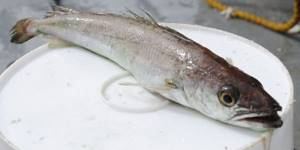
- In addition, there are signs of fish spoilage, which are equally noticeable on the whole carcass and on cut fillets. If pressing on the product with your finger leaves a dent that does not shrink in size, or if you smell ammonia or acid when you bring it to your face, the fish is unfit for consumption.
- But most often hake is sold frozen, since its fresh shelf life is very short. This makes it difficult to check the quality of the product before purchasing. The only indirect way is to check the weight of the package. If it is significantly larger than stated, this indicates that the fish was defrosted and frozen several times.
- When purchasing, it is better to choose fillets that have already been boned. This can significantly reduce your overall prep time. After defrosting, the product should be used quickly and not re-frozen. Once cooked, hake can be stored in the refrigerator for 2-3 days.
- Hake is a soft and delicate fish that does not require much time to cook, so it is best to use moderate temperatures when boiling, stewing or baking. Otherwise, the meat may simply fall apart into fibers.
- Hake fillet is especially recommended for those who follow diets and want to lose weight. Since this fish has very few calories and many beneficial substances that support the body, it can be used in the diet constantly.
- The microelements contained in hake help maintain good condition of hair and nails, which is very important on a long-term low-calorie diet. Some beneficial substances can also speed up weight loss because they improve metabolism. And the high protein content will help preserve muscles.
- Since hake is considered a dietary product, it can be given even to small children, starting from the age of one. However, you must first make sure that you are not allergic to fish and seafood in order to avoid dangerous consequences.
- In general, there are no significant restrictions on the consumption of this fish. The healthiest way to include it in your diet is to eat several portions per week, each weighing 150-200 g. The method of preparation does not matter much (except for deep frying), since hake is always a light food. It is recommended to use it together with stewed
- vegetables and vegetable salads, as they enhance its beneficial properties.
- Hake fish is a healthy and tasty product in the diet of any person. It has great benefits for almost everyone, regardless of age or health, so it is definitely worth purchasing and consuming. To avoid possible harm, you should make sure that there are no contraindications and risk factors associated with hake, of which there are very few.
Fresh frozen
Most often, frozen carcasses are sold with the head on or gutted, as well as filleted. In general, two types of freezing are used for fish: glazed and dry. Glazing is more suitable for hake, which protects the meat as much as possible from various external influences.
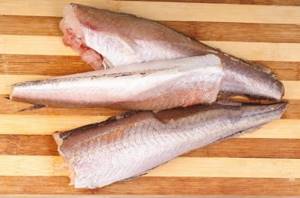
Glazing involves covering fish carcasses with ice and is considered one of the best ways to keep them fresh. According to standards, such a crust should have a thickness of 2-4 mm and not lag behind the surface of the product. If the ice lags behind, it means that the freezing-thawing cycle was repeated more than once, which could significantly deteriorate the quality of hake meat, making it dry, loose, with an unpleasant odor and a higher calorie content.
Important! Hake that has been subjected to repeated freezing can be not only tasteless and high in calories, but also dangerous to health. If bacteria get on defrosted fish, they will not die when re-frozen and can even multiply, which will make it unfit for consumption.
The second sign of a bad product is a yellow tint to the surface of the skin, which indicates that fat oxidation has begun. This happens even when the fish is stored correctly, but for a very long time. In addition, the “victims” of several frosts usually have a dented shape. Once frozen and thawed immediately before cooking, hake retains the maximum taste and aroma of fresh fish, almost all its beneficial properties and its original calorie content - 86 kcal/100 g.
